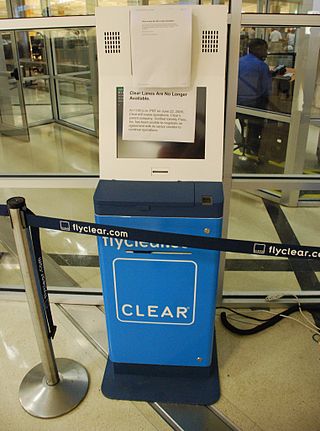Related Research Articles

Border control refers to measures taken by governments to monitor and regulate the movement of people, animals, and goods across land, air, and maritime borders. While border control is typically associated with international borders, it also encompasses controls imposed on internal borders within a single state.

A visa is a conditional authorization granted by a polity to a foreigner that allows them to enter, remain within, or leave its territory. Visas typically include limits on the duration of the foreigner's stay, areas within the country they may enter, the dates they may enter, the number of permitted visits, or if the individual has the ability to work in the country in question. Visas are associated with the request for permission to enter a territory and thus are, in most countries, distinct from actual formal permission for an alien to enter and remain in the country. In each instance, a visa is subject to entry permission by an immigration official at the time of actual entry and can be revoked at any time. Visa evidence most commonly takes the form of a sticker endorsed in the applicant's passport or other travel document but may also exist electronically. Some countries no longer issue physical visa evidence, instead recording details only in immigration databases.

A registered traveler is a person qualified through an airline passenger security assessment system in the United States air travel industry. Such programs were initially tested in 2005. Registered traveler programs are currently in operation in various airports around the country, and are administered by TTAC, the Transportation Security Administration (TSA) office responsible for Secure Flight, the replacement for the Computer Assisted Passenger Prescreening System (CAPPS) and the canceled CAPPS II counter-terrorism system. Registered Traveler is a public and private partnership between the TSA and the Registered Traveler Interoperability Consortium (RTIC) providing rules and standards for private Enrollment Providers that sign up participants. The largest registered traveler program is called Clear, and is operated by Clear Secure, Inc. The Clear access clearance service is currently operating at 60 airports, airports, stadiums, and other venues nationwide as of January 2020.

INSPASS, or INS Passenger Accelerated Service System, was a program of the United States Immigration and Naturalization Service (INS) during the 1990s and early 2000s the purpose of which was to facilitate the entry of pre-screened low-risk travellers through immigration and customs at certain airports.

The National Institute of Migration is a unit of the government of Mexico dependent on the Secretariat of the Interior that controls and supervises migration in the country.

NEXUS is a joint Canada Border Services Agency and U.S. Customs and Border Protection-operated Trusted Traveler and expedited border control program designed for pre-approved, low-risk travelers. Members of the program can avoid waits at border entry points by using reserved lanes at land crossings into Canada and the United States, by using self-serve kiosks at airports in Canada, the US and some international locations, or by phoning border officials for a marine entry. A NEXUS membership card is a valid document under the Western Hemisphere Travel Initiative (WHTI), so it can be used in place of a passport, including by air if flying between the US and Canada. However, carrying a valid passport is still recommended, in the rare event that a flight is diverted to an airport without NEXUS support.

The Western Hemisphere Travel Initiative (WHTI) is the implementation of the requirement to show a passport or other acceptable document to enter the United States, for nationals of certain North American jurisdictions who were previously exempt from it when traveling within the Americas. The requirement was mandated by the Intelligence Reform and Terrorism Prevention Act, enacted in 2004 in response to the terrorist attacks of September 11, 2001, and implemented in phases between 2007 and 2009. According to the U.S. Department of Homeland Security, the purpose is to strengthen border security and facilitate entry into the United States for both U.S. citizens and foreign visitors.

The Secure Electronic Network for Travelers Rapid Inspection (SENTRI) provides expedited U.S. Customs and Border Protection (CBP) processing, at the U.S.-Mexico border, of pre-approved travelers considered low-risk. Voluntarily applicants must undergo a thorough background check against criminal, customs, immigration, law enforcement, and terrorist databases; a 10-fingerprint law enforcement check; and a personal interview with a CBP Officer. The total enrollment fee is $122.50, and SENTRI status is valid for 5 years.

The Programa Pueblos Mágicos is an initiative led by Mexico's Secretariat of Tourism, with support from other federal agencies, to promote a series of towns around the country that offer visitors special experiences because of their natural beauty, cultural richness, traditions, folklore, historical relevance, cuisine, art crafts, and great hospitality. It is intended to increase tourism to more localities, especially smaller towns in rural areas.

Global Entry is a program of the U.S. Customs and Border Protection service that allows pre-approved, low-risk travelers to receive expedited clearance upon arrival into the United States through automatic kiosks at select airports and via the SENTRI and NEXUS lanes by land and sea. As of May 4, 2018, Global Entry was available at 53 U.S. airports and 15 preclearance locations. By April 2018 more than 5 million people were enrolled in Global Entry and approximately 50,000 new applications for the program were being filed monthly.
The visa policy of Canada requires that any foreign national wishing to enter Canada must obtain a temporary resident visa from one of the Canadian diplomatic missions unless they hold a passport issued by one of the 54 eligible visa exempt countries and territories or proof of permanent residence in the United States.

Mexican visas are documents issued by the National Migration Institute, dependent on the Secretariat of the Interior, with the stated goal of regulating and facilitating migratory flows.

The APEC Business Travel Card (ABTC) is a travel document issued to business travellers who are citizens of APEC participating economies. Valid for five years, the card eliminates the need for its holder to possess a visa when visiting other APEC participating economies as long as pre-clearance has been obtained during the application process.

Visa requirements for Pakistani citizens are administrative entry restrictions imposed on citizens of Pakistan by the authorities of other states. As of July 2023, Pakistani citizens had visa-free, visa-on-arrival and eVisa access to 77 countries and territories. All of the updated links and visa-related requirements can be found listed in the chart below. Pakistani passport holders that hold multi-entry visas or permanent residency permits in certain European countries, Canada, USA, GCC states or Australia may grant the ability to apply for eVisas to certain nations, as well as Visa on Arrival access that they would not have without visas to these nations. The Pakistani passport is currently ranked 100th in terms of travel freedom according to the Henley Passport Index in the first Quarter of 2023.
Biometrics refers to the automated recognition of individuals based on their biological and behavioral characteristics, not to be confused with statistical biometrics; which is used to analyse data in the biological sciences. Biometrics for the purposes of identification may involve DNA matching, facial recognition, fingerprints, retina and iris scanning, voice analysis, handwriting, gait, and even body odor.
Visa requirements for crew members are administrative entry restrictions imposed by countries on members of the crew during transit or turnaround.
Many countries have entry restrictions on foreigners that go beyond the common requirement of having either a valid visa or a visa exemption. Such restrictions may be health related or impose additional documentation requirements on certain classes of people for diplomatic or political purposes.

Automated border control systems (ABC) or eGates are automated self-service barriers which use data stored in a chip in biometric passports along with a photo or fingerprint taken at the time of entering the eGates to verify the passport holder's identity. Travellers undergo biometric verification using facial or iris recognition, fingerprints, or a combination of modalities. After the identification process is complete and the passport holder's identity is verified, a physical barrier such as a gate or turnstile opens to permit passage. If the passport holder's identification is not verified or if the system malfunctions, then the gate or turnstile does not open and an immigration officer will meet the person. E-gates came about in the mid-2000s as an automated method of reading the then-newly ICAO mandated e-passports.
Mobile Passport is a mobile app that enables US and Canadian passport holders entering the United States to submit their passport information and customs declaration form to U.S. Customs and Border Protection (CBP) via smartphone or tablet and go through the inspections process using an expedited lane. Mobile Passport is available to U.S. passport holders and Canadian passport holders when entering the United States. The app is available on iOS and Android devices and is operational at 29 airports and 4 seaports. The use of Mobile Passport operations have increased threefold from 2016 to 2017.

TSA PreCheck is a Trusted Traveler program initiated in December 2013 and administered by the U.S. Transportation Security Administration that allows selected members of select frequent flyer programs, members of Global Entry, Free and Secure Trade, NEXUS, and SENTRI, members of the US military, and cadets and midshipmen of the United States service academies to receive expedited screening for domestic and select international itineraries. As of March 2019, this program was available at more than 300 airports.
References
- ↑ "Application". viajeroconfiable.inm.gob.mx. Programa Viajero Confiable.
- 1 2 3 4 Huffman, Lee (August 16, 2015). "The Mexican version of Global Entry". Bald Thoughts.
- ↑ "Viajero Confiable México | Instituto Nacional de Migración | Gobierno | gob.mx".
- ↑ "Cross often? Make it simple, use NEXUS". www.cbsa-asfc.gc.ca. Archived from the original on 2007-11-03.
- ↑ "Border Facilitation". PM.gc.ca. June 29, 2016.
- ↑ Myers, Gay Nagle (June 2, 2015). "Mexico Trusted Traveler Program to Expand". Travel Weekly.
- ↑ "Trusted Traveler Programs". Canadian Border Patrol.